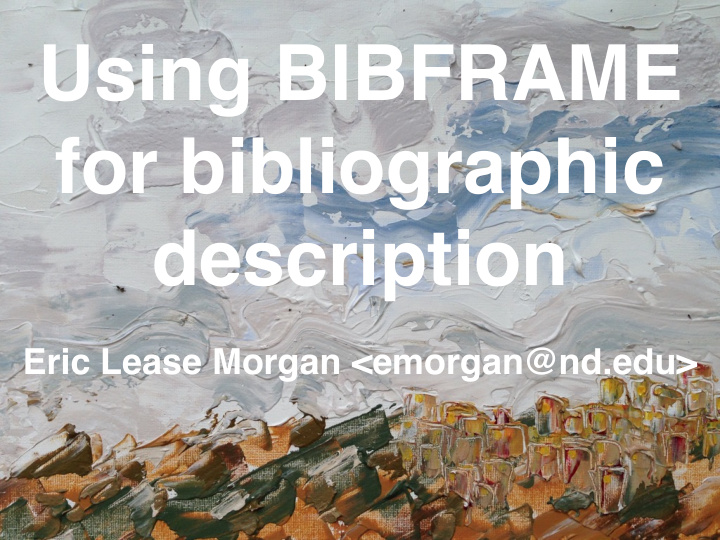



Using BIBFRAME for bibliographic description Eric Lease Morgan <emorgan@nd.edu>
Librarianship as collections & services
Bibliographic description: an informal history
Resource Description Framework
RDF example #1 / --- a predicate ---------> [ an object ] [ subject ] - | --- another predicate ---> [ another object ] \ --- a third predicate ---> [ a third object ] | | yet another predicate | | \ / [ yet another object ]
RDF example #2 / --- has name ------------> [ "Rome" ] | --- has description -----> [ "A long time ago… [ http://example.org/rome ] - | --- has founding date ---> [ "1000 BC" ] | --- is a sub-part of ---> [ http://example.org/italy ] \ --- is a type of --------> [ http://example.org/city ]
Linked data
Linked data example #1 <?xml version="1.0"?> <rdf:RDF xmlns:rdf="http://www.w3.org/1999/02/22-rdf-syntax-ns#" xmlns:dcterms="http://purl.org/dc/terms/" xmlns:foaf="http://xmlns.com/foaf/0.1/"> <rdf:Description rdf:about="http://en.wikipedia.org/wiki/Declaration_of_Independence"> <dcterms:creator> <foaf:Person rdf:about="http://id.loc.gov/authorities/names/n79089957"> <foaf:gender>male</foaf:gender> </foaf:Person> </dcterms:creator> </rdf:Description> </rdf:RDF>
Linked data example #2 @prefix foaf: <http://xmlns.com/foaf/0.1/>. @prefix rdf: <http://www.w3.org/1999/02/22-rdf-syntax-ns#>. @prefix dcterms: <http://purl.org/dc/terms/> . <http://en.wikipedia.org/wiki/Declaration_of_Independence> dcterms:creator <http://id.loc.gov/authorities/names/n79089957> . <http://id.loc.gov/authorities/names/n79089957> a foaf:Person; foaf:gender "male".
BIBFRAME
Workflow (Part I) 1. Answer the questions, "What is bibliographic description, and how does it help facilitate the goals of librarianship?" 2. Understand the concepts of RDF and linked data. 3. Embrace & understand the strengths & weaknesses of BIBFRAME as a model for bibliographic description. 4. Design or identify and then install a system for creating, storing, and editing your bibliographic data. This will be some sort of database application whether it be based on SQL, non-SQL, XML, or a triple store. It might even be your existing integrated library system.
Workflow (Part IIa) Using the database system, create, store, import/edit your bibliographic descriptions. For example, you might simply use your existing integrated library for these purposes, or you might transform your MARC data into BIBFRAME and pour the result into a triple store…
Workflow (Part IIb) A.Dump MARC record B.Transform MARC into BIBFRAME C.Pour the result into a triple-store D.Sort the triples according to the frequency of literal values E. Find/replace the most frequently found literals with URIs F. Go to Step #D until tired G.Use the triple-store to create & maintain ongoing bibliographic description H.Go to Step #D
Workflow (Part III) 6. Expose your bibliographic description as linked data by writing a report against the database system. This might be as simple as configuring your triple store, or as complicated as converting MARC/AACR2 from your integrated library system to BIBFRAME. 7. Facilitate the discovery process, ideally through the use of linked data publishing and SPARQL, or directly against the integrated library system. 8. Go to Step #5 on a daily basis. 9. Go to Step #1 on an annual basis.
Prototypical implementation
Summary http://infomotions.com/blog/2016/03/bibframe/
Recommend
More recommend